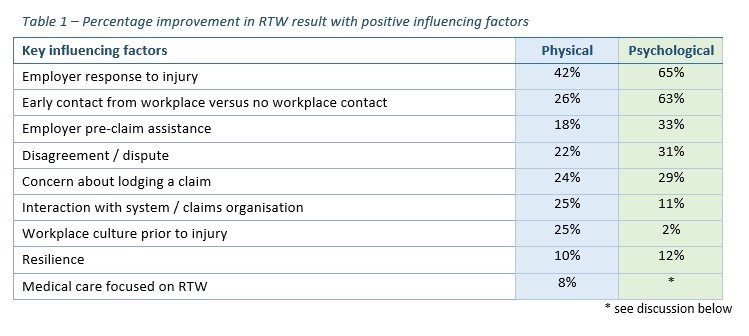Will workers’ comp scandals overshadow pervasive human costs?
The recent Four Corners1 expose on workers' compensation highlighted the costs of poor case management practices in Victoria and NSW.
Read MoreWe started Return to Work Matters 10 years ago, with the aim of fostering constructive approaches to managing people who’ve experienced a work injury. Although we hope that we’ve made a difference to our readers, unfortunately if we look at the broad Australian picture we don’t see overarching improvements in return to work results.
The 2016 National Return to Work Survey showed no improvement in return to work rates over a ten year period. (The 2018 version of this biennial survey is is due out soon.)
What has led to this stagnation?
In my view, there are three key stumbling blocks preventing RTW improvements in Australia.
Firstly, many individual organisations and workers’ compensation jurisdictions continue to focus on controlling costs at the expense of workout wellbeing. This is not an effective approach by any measure, because when worker wellbeing suffers costs tend to go up, not down.
I imagine this situation is particularly frustrating for return to work professionals who have a grasp on good practice, but lack the organisational clout to bring about a shift in focus. Hang in there – as I discuss later, there are some signs that change is coming.
Secondly, we see some systems continuing to have high levels of claim disputation, often also counter-productive.
And finally, I continue to see patients feeling worn out by the challenges of dealing with scheme processes and bureaucracy. This exhaustion and sense of overload negatively impacts workers’ capacity to recover and get back to work in a timely way.
My personal observations are supported by evidence. A few years ago, I analysed data from the 2013 and 2014 National Return to Work surveys, on behalf of Safe Work Australia.
The data showed that, when an employer’s response to a worker’s injury was positive, the RTW rates for workers with physical injuries were 42% higher (87% at work with positive response versus 61% without a positive response). In psychological cases, the RTW result with a positive employer response was 52% higher (79% versus 52%).
Other factors were of influence too, as you can see in the table below. The quality of interaction with the insurer / claims agent is another major factor in whether someone gets back to work.

There’s more.
In 2012, I collaborated on research into the cost effectiveness of a RTW intervention based on principles of early appropriate intervention, proactive management of the return to work process and supporting the worker. My research partners were Ross Iles (then from La Trobe University) and Glen Pransky (from the now sadly defunct Liberty Mutual Research Institute for Safety, Boston, in the US).
Compared to organisations that stuck with their usual injury management systems, those who participated in the intervention had significantly fewer days of compensation lower medical costs and lower weekly benefits. Overall the average cost of a claim was $3,913 post intervention compared to $6,019 for the pre intervention period. And the average number of days off work was reduced from 33 to 14 days.
Thankfully, some Australian workers’ compensation authorities are beginning to pay attention to the evidence.
Some jurisdictional changes have focused on strategies that have been shown to be effective, such as early reporting by phone and a strong focus on providing suitable duties. In some parts of Australia, there is now more emphasis on quality case management, and fewer claims disputes.
At the organisational level, individual businesses are more likely to be looking for cases that may become more complex, and offering greater levels of support early on. There’s a growing awareness of the impact of psychosocial issues, and more early reporting.
We also see many groups actively promoting a more positive workplace culture, and raising awareness of mental health at work. In some quarters, good workplace management underpins good return to work management. For example, the excellent work of Superfriend and SafeWork Australia.
There needs to be more of all these things; and governments need to be doing more to raise employer awareness of the many benefits of adopting a supportive approach.
The benefit for workers is clear, but this may not be enough to persuade all organisations to take action. Businesses tend to look to the bottom line, so corporate Australia needs to know that there are clear and significant financial benefits associated with an enlightened approach to workplace injury management.
The evidence is out there, which means that the stage is set for action. I hope that in ten years we’ll be able to look back on this time as a tipping point, where we began to see employers, government, treating professionals, insurers and rehabilitation providers all working together to see better results for Australian business and workers.
Source: At Work, Issue 93, Summer 2018: Institute for Work & Health, Toronto
Written by Dr Mary Wyatt
Reproduced with permission from Return to Work Matters Ptd Ltd. For more articles, visit here.